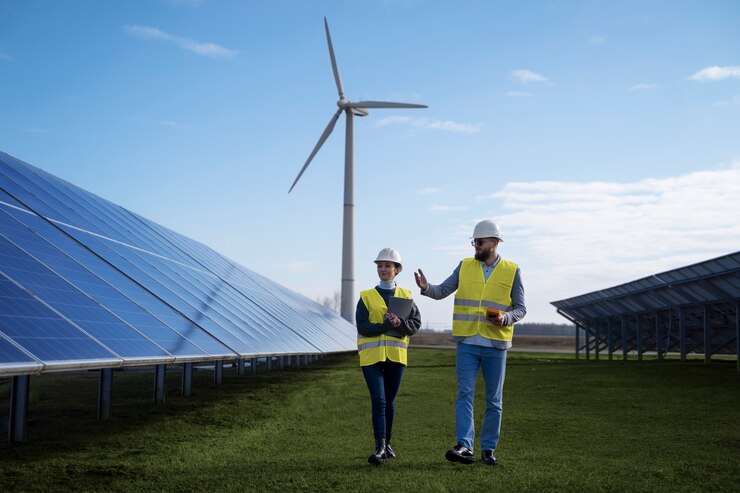Green energy has gained global attention due to the pressing need for sustainable energy solutions that combat climate change. With rising concerns over the environmental impacts of fossil fuels, green energy offers a cleaner, renewable alternative. This article explores green energy in detail, covering its definition, types, examples, and a comparative analysis of different green energy sources.
What is Green Energy?
Green energy refers to energy produced from natural, renewable sources such as sunlight, wind, and water. These sources generate electricity without causing significant harm to the environment, unlike fossil fuels, which release greenhouse gases and contribute to global warming.
Green energy differs from other renewable energy sources in that it must have a minimal environmental impact. For example, biomass energy, which involves burning organic materials, may be considered renewable, but it is not always deemed “green” due to the release of carbon dioxide during the burning process.
Importance of Green Energy
Green energy is crucial for addressing climate change and reducing pollution. It replaces fossil fuels, thereby reducing the emission of harmful greenhouse gases. Green energy also has economic advantages, creating jobs in renewable energy sectors and offering stable energy prices that are less influenced by geopolitical tensions and market fluctuations.
Types of Green Energy
Several types of green energy are available today, each with its advantages, challenges, and potential for growth. The following are the main types:
1. Solar Power

Solar power is one of the most well-known examples of green energy. It captures sunlight using photovoltaic cells, converting it into electricity. Solar energy is versatile, used in both residential homes and large-scale solar farms. It can power everything from small gadgets to entire cities. Solar energy systems are also used for heating, lighting, and hot water.
Example: Solar panels installed on homes reduce electricity bills and carbon footprints.
2. Wind Power
Wind energy harnesses the power of air movement to generate electricity using wind turbines. It is most effective in offshore locations or areas with high wind speeds, such as mountains or open plains. Wind energy is increasingly being used worldwide to supplement traditional power sources.
Example: Offshore wind farms in Europe provide substantial electricity to millions of homes.
3. Hydropower
Hydropower, also known as hydroelectric energy, uses the movement of water—whether from rivers, streams, or tidal waves—to generate electricity. Large-scale hydropower plants can produce massive amounts of energy, while smaller systems can be installed in homes or businesses.
Example: The Hoover Dam in the United States is a prominent example of hydropower in action.
4. Geothermal Energy
Geothermal energy taps into the Earth’s internal heat to generate electricity. This energy source is often accessed by drilling wells deep into the Earth’s crust to release hot water or steam that powers turbines. While location-dependent, geothermal energy offers vast potential, especially in regions with volcanic activity.
Example: Iceland relies heavily on geothermal energy for both electricity and heating.
5. Biomass
Biomass energy is produced from organic materials such as wood, agricultural waste, and even animal manure. While renewable, biomass energy must be carefully managed to avoid harmful emissions. For example, burning wood waste can release greenhouse gases, so the process must be optimized for minimal environmental impact.
Example: Biomass plants convert agricultural waste into electricity, reducing the need for fossil fuels.
6. Biofuels

Biofuels are a type of biomass energy converted into liquid fuels such as ethanol and biodiesel. They are commonly used in transportation, providing a renewable alternative to gasoline and diesel.
Example: Ethanol, derived from corn or sugarcane, is used as a biofuel in many countries to power vehicles.
Comparative Analysis of Green Energy Sources
To understand the advantages and disadvantages of various green energy sources, it’s important to compare their efficiency, cost, and environmental impact.
| Energy Source | Efficiency | Cost per kWh | Environmental Impact |
|---|---|---|---|
| Solar Power | 15-20% | $0.06 – $0.10 | Minimal |
| Wind Power | 30-45% | $0.04 – $0.08 | Minimal |
| Hydropower | 90% | $0.02 – $0.05 | Potential habitat loss |
| Geothermal Energy | 10-20% | $0.05 – $0.12 | Minimal, localized drilling |
| Biomass | 20-30% | $0.10 – $0.15 | Emissions depend on feedstock |
| Biofuels | Varies | $1.00 – $1.50 (per gallon) | Moderate emissions during combustion |
Benefits of Green Energy Solutions
Green energy solutions offer numerous benefits, not just for the environment but also for economies and societies.
- Environmental Impact Reduction: Green energy sources generate little to no greenhouse gases or other harmful emissions.
- Sustainability: Unlike fossil fuels, which are finite, green energy sources are renewable and continuously replenished.
- Energy Security: By reducing reliance on imported fossil fuels, green energy boosts energy independence and security.
- Job Creation: The renewable energy industry creates millions of jobs in sectors like solar panel installation, wind turbine construction, and geothermal energy management.
Can Green Energy Replace Fossil Fuels?
While green energy shows great promise, replacing fossil fuels entirely will require significant advancements in technology, infrastructure, and policy. Different geographic locations may favor different types of renewable energy, such as geothermal in Iceland or wind energy in the United Kingdom.
Nevertheless, with continued investment and innovation, green energy can gradually phase out fossil fuels.
Green Energy vs. Renewable Energy: What’s the Difference?

Although green energy and renewable energy are often used interchangeably, they are not always the same. Renewable energy refers to energy sources that are replenished naturally, but not all renewable sources are considered green. For example, hydropower is renewable, but large dams may disrupt ecosystems and are not considered fully “green.”
Types of Green Energy: A Closer Look
Green energy can be categorized into different types, including:
- Solar Energy: Solar panels capture sunlight and convert it into electricity or heat.
- Wind Energy: Wind turbines use the kinetic energy from wind to generate electricity.
- Geothermal Energy: Heat from beneath the Earth’s surface is converted into electricity.
- Hydropower: The movement of water is used to generate electricity.
- Biomass Energy: Organic materials like wood or agricultural waste are burned or processed to produce energy.
The Economic Viability of Green Energy
The cost of green energy technologies has been falling steadily, making it an economically viable option for both developed and developing countries. Solar and wind power, in particular, have become cheaper than coal or natural gas in many regions.
| Technology | Initial Investment | Maintenance Cost | Return on Investment |
|---|---|---|---|
| Solar Power | High | Low | High |
| Wind Power | High | Moderate | High |
| Hydropower | High | Low | Moderate |
| Geothermal Energy | High | Low | High |
Examples of Green Energy in Action
Green energy solutions are already in use across multiple sectors, including:
- Buildings: Solar panels for homes, geothermal heating systems, and biomass boilers are common examples of green energy in buildings.
- Industry: Many industries use green energy to power manufacturing processes or reduce emissions.
- Transportation: Electric vehicles and biofuels are leading the charge in reducing fossil fuel use in transportation.
Which Green Energy Source is Most Efficient?
Wind power is considered one of the most efficient sources of green energy, with an efficiency rate of 30-45%. Solar power follows closely, while hydropower boasts the highest efficiency at 90%. However, hydropower’s environmental impact must be carefully managed.
How Green Energy Helps the Environment
Green energy reduces the emission of harmful gases and pollutants. By using renewable resources like sunlight, wind, and water, green energy creates a sustainable future while minimizing harm to ecosystems.
Conclusion
Green energy represents the future of sustainable power generation. From solar and wind power to geothermal and hydropower, these sources provide clean, renewable alternatives to fossil fuels. By investing in green energy solutions, we can create a healthier, more sustainable future for generations to come.
As we continue to develop technologies and infrastructure for green energy, its potential to replace fossil fuels will only grow. The future is green, and the renewable energy industry is at the forefront of this transformation.




